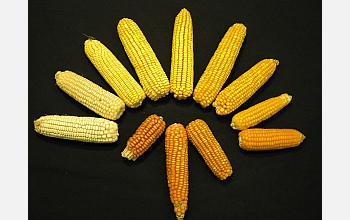Corn can grow in many places but from a nutritional point of view, its fiber benefits are offset by its poor vitamin content.
Deficiencies in vitamin A cause eye diseases, including blindness, in 40 million children annually, and increased health risks for about 250 million people, mostly in developing countries.
It makes sense to find ways to improve corn planting so that corn with more nutritional value will be in use and a team of researchers say they have done just that. This is not genetic modification of corn, this is a tool that analyzes "the genetic makeup of corn that will enable developing countries to identify and increase cultivation of corn that has naturally high levels of vitamin A precursors," says Ed Buckler, a co-leader of the research team from the U.S. Department of Agriculture, Agricultural Research Service and Cornell University.
Corn is the dominant subsistence crop in sub-Saharan Africa and Latin America, where 17 to 30 percent of children under age five are vitamin A deficient, says Buckler. Because corn is consumed for all three meals a day in much of Africa, it is a good target for vitamin biofortification, he added.

Since corn is already an essential part of the diets of hundreds of millions of people around the world, regular consumption of corn high in vitamin A precursors, which are converted in the human body into vitamin A, would reduce their chances of developing vitamin A deficiencies and associated health problems.
Corn has a wide degree of genetic diversity so knowing which types are best for nutrition is difficult for residents in third world countries.
"In a field of thousands of ears of corn, each ear has a slightly different genetic makeup and resulting differences in physical characteristics, including levels of vitamin A precursors -- just like every person in a crowd has a slightly different genetic makeup and associated physiological differences," explains James Collins, assistant director for the Biological Sciences Directorate at NSF. But only a very small percentage of corn crops are genetically programmed to have naturally high levels of vitamin A precursors, and these high-vitamin ears cannot be identified merely by visual inspection. "Therefore, identifying crops that have high levels of vitamin A precursors has traditionally been like finding a needle in a haystack."
But the team led by Buckler and Torbert Rocheford of the University of Illinois has significantly simplified the task of sifting through that proverbial haystack. They did so by identifying genetic markers in corn that are associated with high levels of vitamin A precursors. These markers can be used by "scientists working in very basic labs in developing countries to quickly screen for local corn strains that are high in vitamin A precursors," says Buckler. Then, these high-vitamin strains may be bred, cultivated and consumed by local people.
Buckler says that his team's method for analyzing the genetic makeup of corn is "much simpler and faster and up to 1,000-fold cheaper" than running the types of chemical tests that were previously available for identifying corn high in vitamin A precursors. He expects it to significantly accelerate the vitamin biofortification of corn crops.
The Buckler and Rocheford team is currently working with various international organizations, such as CIMMYT (the International Maize and Wheat Improvement Center) and the International Institute for Tropical Agriculture, to help train plant breeders in developing countries to use their techniques.
Buckler says that this new method of increasing cultivation of high-vitamin corn was made possible by recent breakthroughs in statistical analyses and the advent of rapid DNA sequencers -- instruments that are used to automate genetic profiling of crops. The researchers expect this new method to have broad applications beyond corn improvement.





Comments